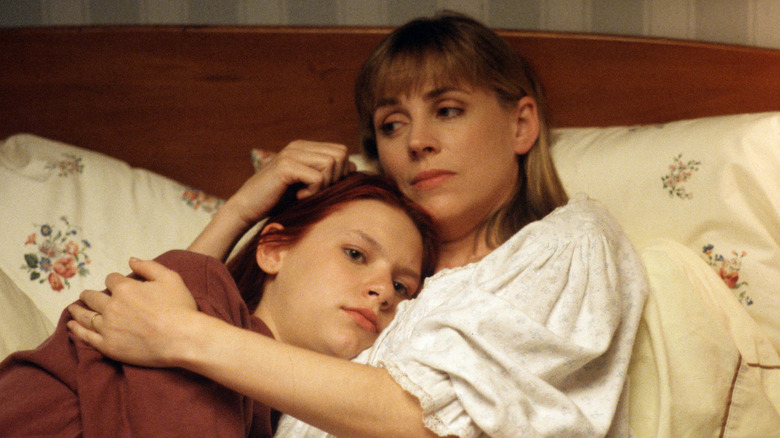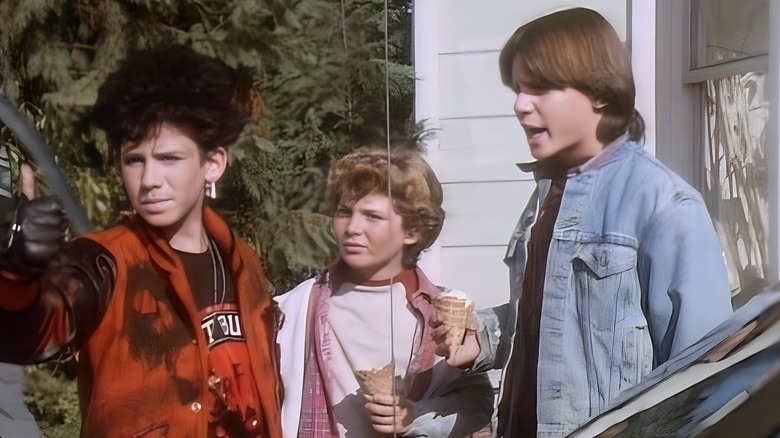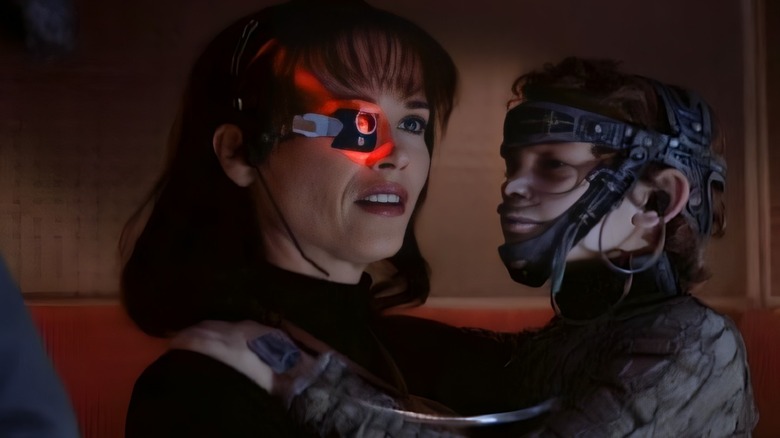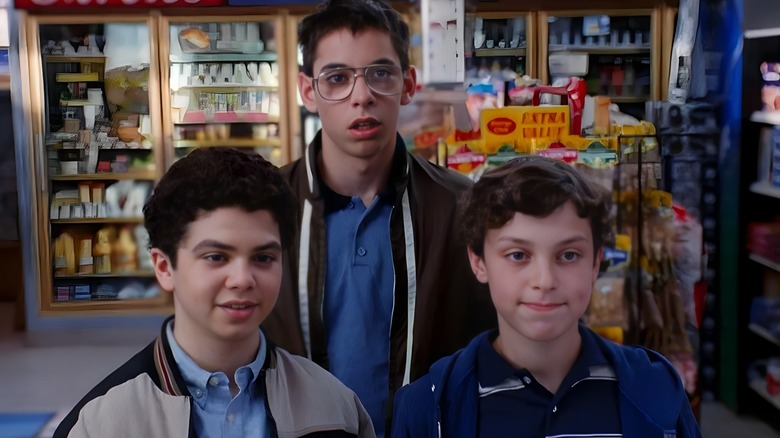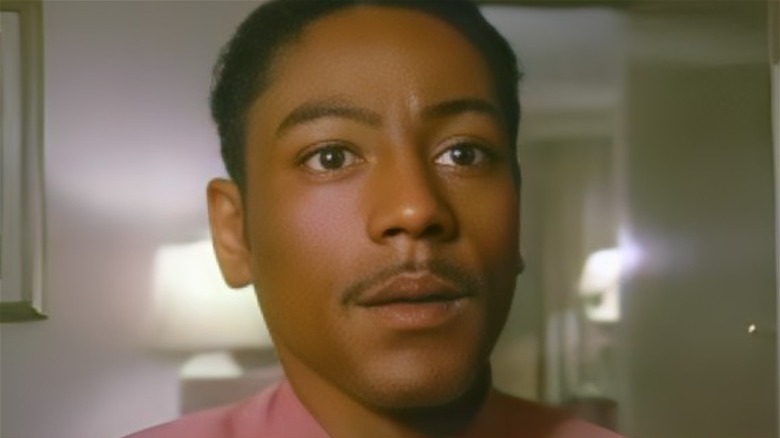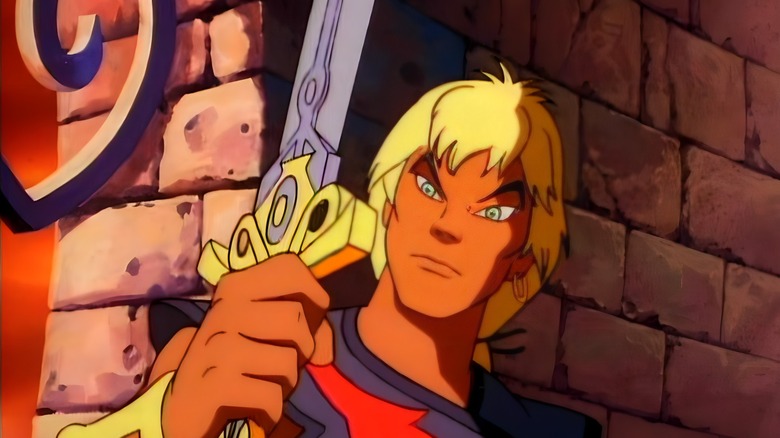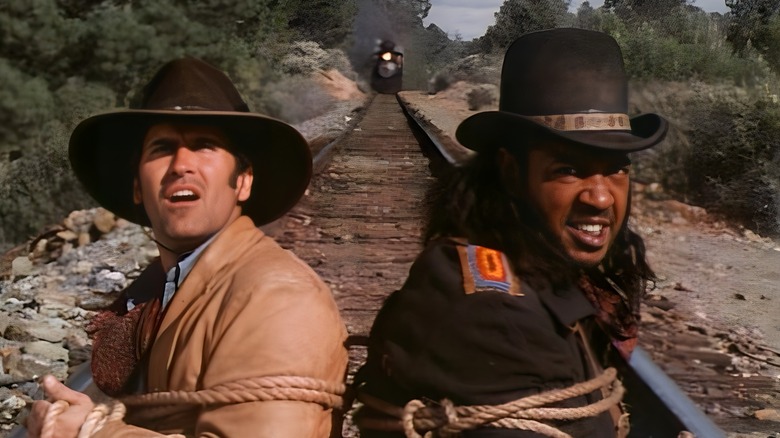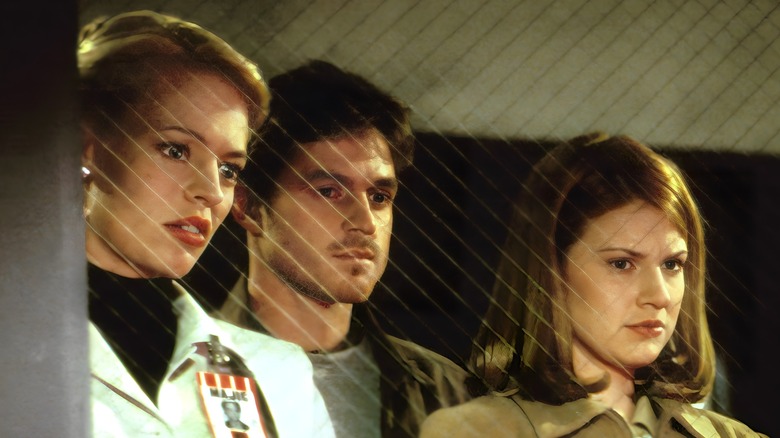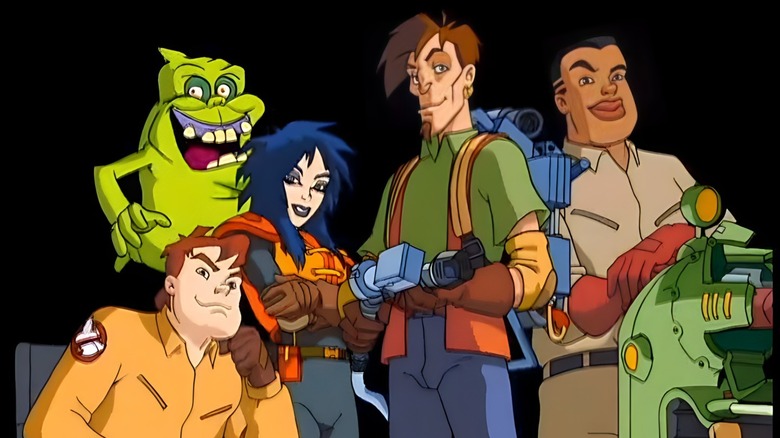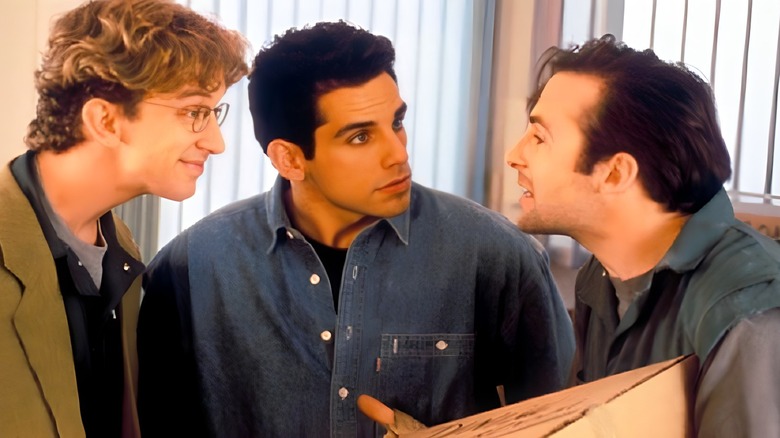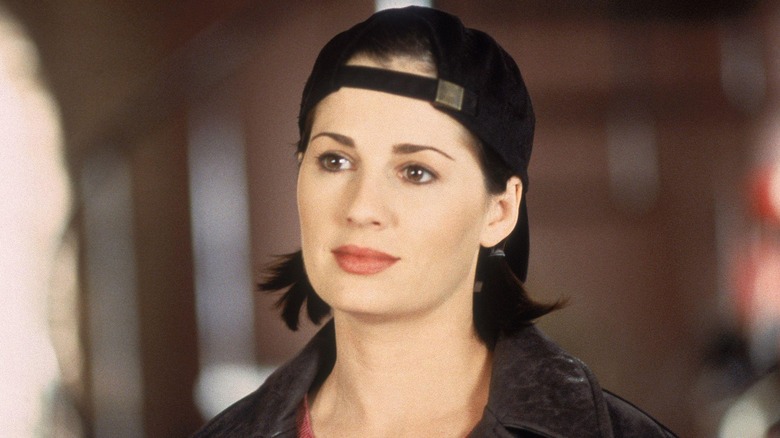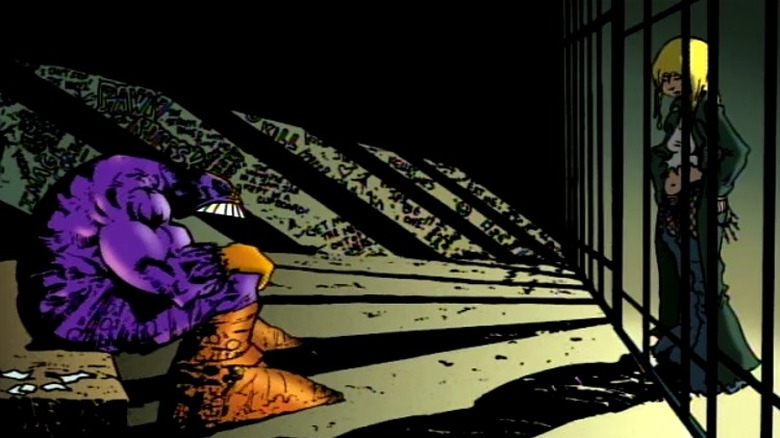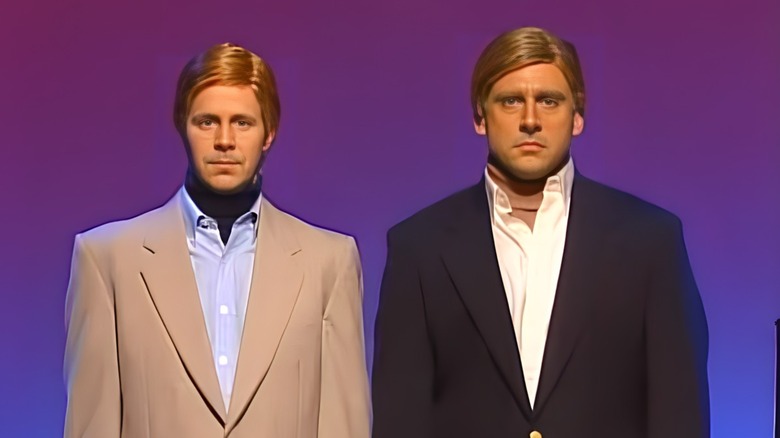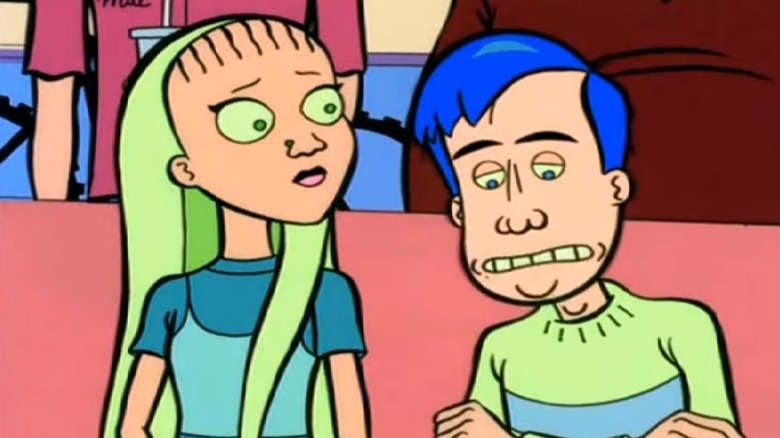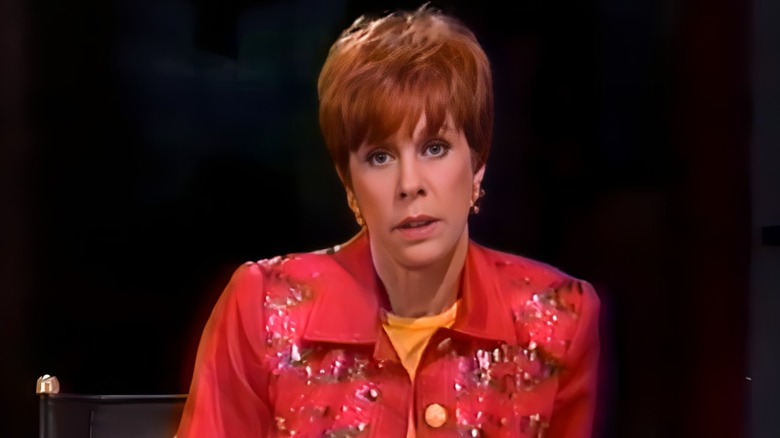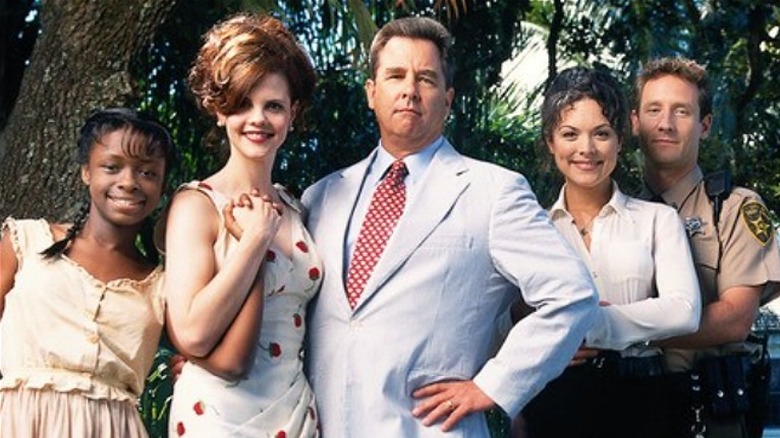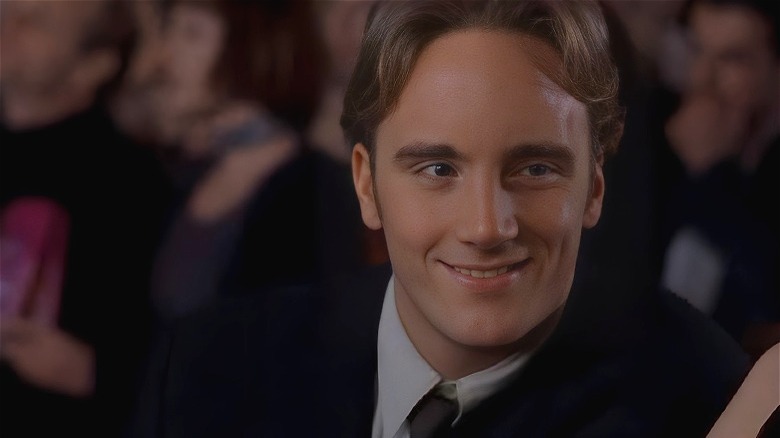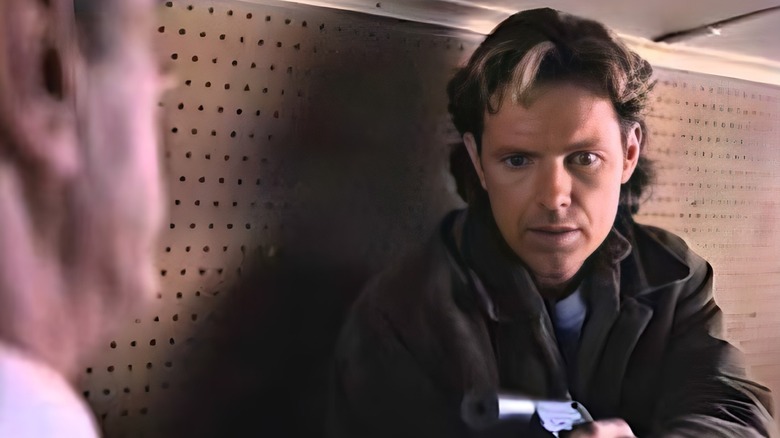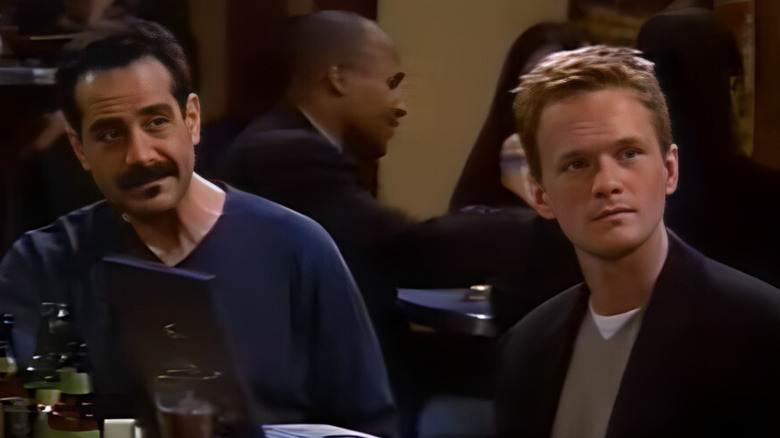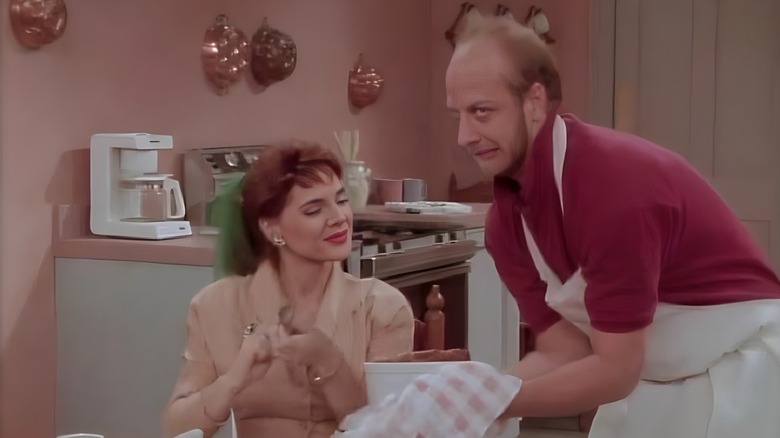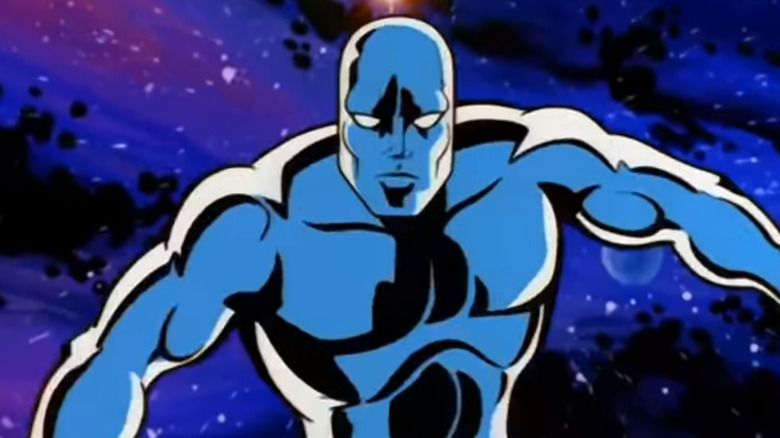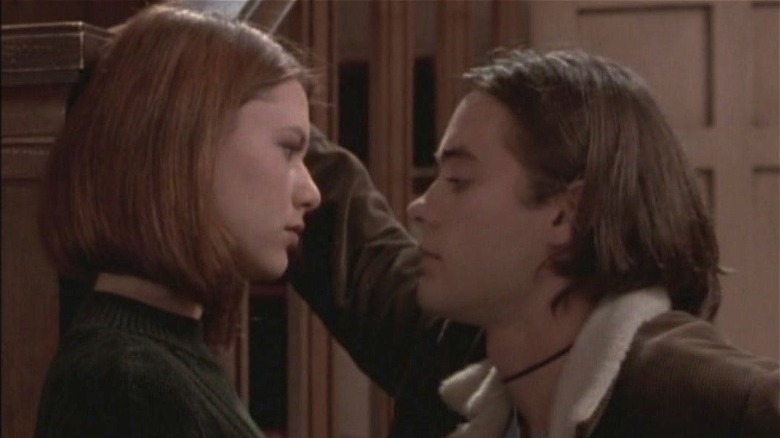'90s TV Flops That Are Actually Worth Watching
The 1990s were truly a golden age for television. All of the major genres were firing on all cylinders — no matter what type of television you enjoyed most, there was plenty of it to be found throughout the decade. Americans were also watching a lot of TV in the '90s, as top-rated shows like "Friends," "ER," and "Law and Order" would regularly pull in between 15 and 30+ million viewers week to week. By contrast, the most-watched sitcom on broadcast TV right now is "Young Sheldon," which didn't even average 10 million per week in its 2022-23 season.
The downside to TV being so hot in the '90s is that it set the bar extremely high for what was and wasn't considered a success. Whereas 10 million viewers is now seen as a huge ratings winner, 30 years ago it meant a show being put on the chopping block. A number of great shows were victims of these expectations, and were canceled before they had the time to find an audience because they weren't doing the massive numbers that the era required. There also wasn't streaming or the ability to buy seasons of a show on DVD yet, so networks weren't willing to take a loss on an underperforming series because there wasn't any sort of secondary market to recoup their losses. These shows may have all been cut down far too soon and considered failures at the time, but they hold up well enough to revisit today.
Eerie, Indiana
Kid-centric horror was all the rage in the '90s, from "Are You Afraid of the Dark?" to "Goosebumps" and beyond. Given the popularity of the subgenre, it's pretty surprising that "Eerie, Indiana" was only a single-season wonder — especially when it was probably the best of its kind to be released during that era. Perhaps it's because it was on NBC and had a prime time slot, so it needed to have major network prime time numbers to survive. Had it been an afternoon show, or on a less-discriminating network, it might have had the longevity it deserved.
Starring Omri Katz, best known as Max Dennison from "Hocus Pocus," "Eerie, Indiana" was about the titular town and all of the bizarre goings-on that seemed to always be happening there. Sometimes the show tackled popular myths like Elvis faking his own death to live a private life, while plenty of other episodes were built around entirely new — and often extremely inventive — scenarios. Critics referenced creators like Stephen King and David Lynch in their praise of the show, while multiple articles compared the vibe to that of the movie "Edward Scissorhands." Sadly, good reviews alone don't keep a show on the air, and "Eerie, Indiana" got only 19 episodes before it was canceled in 1993.
Earth 2
Another genre that was having a moment in the '90s was sci-fi. Not only did three different "Star Trek" series overlap during the decade, but shows like "The X-Files," "Babylon 5," "Earth: Final Conflict," and "seaQuest DSV" all found an audience and brought their own unique spins to the genre. There was even an extremely successful sci-fi sitcom, "3rd Rock from the Sun," that proved to have surprising acclaim and longevity for a show with such a novelty-type premise.
But there were plenty that didn't make it as well, even ones that deserved to. One hidden gem that got lost in the shuffle was "Earth 2," another single-season NBC show that couldn't find the viewership it needed despite strong reviews — even later earning three Emmy nominations and winning the award for Visual Effects. Taking place in the year 2192, the show imagined a future where Earth has become unlivable and what remains of mankind is forced to live on space stations, trying to reach a distant planet that seems to be inhabitable. While fans only got 21 episodes of "Earth 2," they at least got two novels of original stories that take place in the show's universe, plus a novelization of the first two episodes. Beyond the dated special effects, "Earth 2" remains watchable today — even if its depiction of a future uninhabitable Earth feels even more uncomfortably close now than it did in 1995.
Freaks and Geeks
This one is a lot more well-known than most of the other shows on this list, and has had plenty of subsequent reappraisal and recognition for what a great show it was — and still is. But that doesn't change the fact that "Freaks and Geeks" got a criminally short run of only 18 episodes after its September 1999 debut before NBC pulled the plug. Meanwhile, critics were nearly unanimous in their love for the show, and two different episodes were nominated for Outstanding Writing in a Comedy Series at the Emmys.
The Emmy that "Freaks and Geeks" actually won — Outstanding Casting for a Comedy Series — shouldn't come as a surprise given that its ensemble included soon-to-be-A-listers Seth Rogen, Jason Segel, and James Franco. Not to mention Martin Starr, Linda Cardellini, John Francis Daley, Busy Phillips, and Samm Levine, all of whom have remained film and television mainstays ever since. There are no shortage of coming-of-age shows that look back at a previous generation, but "Freaks and Geeks" stood out both for its honest depiction of the less-popular crowd as well as paying tribute to its era without descending into parody. Oh, and its creator and executive producer? That would be Paul Feig and Judd Apatow, respectively, who would become some of the biggest comedic voices in Hollywood a short time later.
Bakersfield P.D.
For a while now, audiences have been embracing single-camera television comedies that aren't filmed in front of an audience, don't have a laugh track, and are shot more like dramas. But in 1993, that was still a novelty, and people didn't quite know what to make of funny shows that didn't fit into the standard sitcom mold. This all but doomed the brilliant but largely forgotten "Bakersfield P.D.," which was too ahead of its time for its own good.
Starring Giancarlo Esposito — before "The Mandalorian," before "Breaking Bad," even before "Homicide: Life on the Street" — the show followed Esposito's Detective Paul Gigante, a big-city cop who suddenly finds himself out of his element in a small-town police department. Also featuring veteran character actor Brian Doyle-Murray, the show lampooned police procedurals in a manner not entirely unlike "Brooklyn Nine-Nine," being just as silly at times but playing it a lot straighter.
It's possible that the show could have been given a little time to find its audience despite its unorthodox (for the time) approach, but it was on Fox at a time when that network was still struggling to define itself and had little choice but to cancel anything that wasn't a near-instant ratings success.
The Pirates of Dark Water
Plenty of cartoons come and go. In fact, it's actually somewhat rare for a kids' cartoon to have more than a season or two, especially during the '90s, because that was usually all that was needed to rerun it for the next five-plus years. But there were still a few that got cut short yet stuck around long enough that they are still looked back upon — and still watched — with the same reverence as the likes of "Animaniacs," "Teenage Mutant Ninja Turtles," et al. One of those shows is "The Pirates of Dark Water."
A Hanna-Barbera production that ran on the now-defunct Fox Kids programming block, "Pirates" hit that rare older kids/younger teens sweet spot flawlessly. A hybrid of old-school swashbuckling pirate adventure with hints of sci-fi and fantasy, the show started with an epic five-part miniseries that told a much bigger story than most cartoons at the time would have even attempted. Only the five-part Phoenix Saga from "X-Men: The Animated Series" came close in terms of ambition and scope.
But like so many kids' cartoons that tried to tell deeper, more complex stories with elaborate worldbuilding — not to mention having a higher caliber of animation than was typically seen (except for anime) on TV at the time — "The Pirates of Dark Water" was not long for this world and got only a single full season, plus an extremely truncated second season, before being sunk.
The Adventures of Brisco County, Jr.
Cult film favorite Bruce Campbell has long been just as prolific on the small screen as he has in movies. He's had some big successes with the former as well, most notably as a series regular for all seven seasons of the spy-based 2007-2013 action series "Burn Notice." But the television role that's a lot more in line with what people expect from Campbell came nearly 15 years earlier, when he starred in the Western sci-fi comedy "The Adventures of Brisco County, Jr."
In the show, Campbell played Brisco County, a wise-cracking bounty hunter who doesn't seem particularly good at his job but somehow always seems to fumble his way out of trouble. Created by the writing team behind "Indiana Jones and the Last Crusade," the show definitely has elements of that film series, with clever writing and consistently satisfying action throughout. It was perhaps a bit too subversive for the time, and Campbell wasn't quite the household name yet that he'd eventually become, with his loyal but still relatively niche fan base not yet large enough to sustain a pricey network television action/adventure show.
Ahead of its time for many reasons — not the least of which was its refreshingly multiracial cast — "The Adventures of Brisco County, Jr." should be sought out by not only Bruce Campbell fans but fans of similar works like "Indiana Jones," "Firefly," and "Back to the Future Part III."
Dark Skies
"The X-Files" was a huge series throughout its run, and it had other networks — as well as Fox itself — trying to replicate the show's success. NBC took a crack at it with "Dark Skies," which was dismissed by some critics as a mere clone of "The X-Files" due to just how similar the two series were. On the other side of the coin, there are some, particularly in retrospect, who have made the case that "Dark Skies" is actually the superior of the two shows.
The truth that was ultimately out there is that "Dark Skies" didn't have the ratings to grant it more than 20 episodes, causing it to suffer the same fate as most "X-Files"-inspired shows. But it was arguably the best, with a unique premise that saw it taking place in an alternate history 1960s in which aliens had been on Earth since the '40s, with the government having kept their existence a secret from the public. It also didn't shy away from depicting real people, including politicians, actors, musicians, and more. It would go on to win an Emmy award for its title design.
Extreme Ghostbusters
A lot of people probably dismissed this show outright based purely on the title, with the '90s marketing tactic of calling everything "extreme" having grown tiresome by 1997. Plus, the "Ghostbusters" brand was languishing a bit at this point, years removed from the last movie or previous cartoon series and quite a ways off from the next thing — which would be 2009's "Ghostbusters: The Video Game."
A lot seemed to be working against "Extreme Ghostbusters." But the show itself was great, seemingly a kids' show but with enough depth and cleverness to the writing and the stories to appeal to adults as well. It was the perfect show for older fans of the franchise to watch with their children as a means of introducing it to them. "Extreme Ghostbusters" also did a fantastic job at introducing a new generation of characters while also including the old ones, and having them all co-exist and be equally important to the plotlines.
The show did get a commendable 40 episodes, but it never got a second season. The new characters have been relegated to small appearances in the comics and video games, while sadly left out of the film franchise entirely.
The Ben Stiller Show
Prime time sketch comedy on regular network television is something that rarely works. But that hasn't stopped many from trying it over the years, including a group of young up-and-comers in the early '90s that included a combination of future superstars and hugely influential comedy writers. That group — including Ben Stiller, Bob Odenkirk, Judd Apatow, David Cross, Janeane Garofalo, and Dino Stamatopoulos — came together to write and star in "The Ben Stiller Show."
After getting its start on MTV, the version of "The Ben Stiller Show" that people are generally more aware of is the one that ran on Fox for only 12 episodes, leaving an unaired episode that Comedy Central later added to its rerun package of the show. Like most sketch comedy, the scenes could be a bit hit or miss, but the talent and chemistry of the cast couldn't be denied. The writing was also worthy of an Emmy win, even though the show had already been canceled by the time the crew took home their trophy. Not all of it has aged well, especially jokes focused on then-current celebrities, movies, and TV shows, but it's still worth looking back at these soon-to-be-stars taking what is, for most of them, their first real crack at an on-screen career.
Cupid
Typically, Saturday night prime time is where networks put shows that the execs aren't sure about, and then move them to a better day if they do well. The rare shows that do stick around for an extended period in the 8 p.m. to 10 p.m. EST Saturday time slot are typically aimed at older viewers. So for a show that is clearly going for young, hip, and fresh — like 1998's "Cupid" — to be launched at the 10 p.m. EST Saturday time slot by ABC, it smacked of a network that didn't fully believe in it.
The series followed a man named Trevor Hale (Jeremy Piven) who is convinced he is in fact the mythological god Cupid, but is institutionalized for what everyone else sees as a delusion. But that does allow him to meet Claire (Paula Marshall), a psychologist who doesn't fully believe Trevor but does decide to roll the dice and set him free to complete his mission to bring 100 couples together — at which point, he claims, Zeus will reinstate his powers and let him return to Mount Olympus. We never learned if Trevor was telling the truth, as "Cupid" was canceled after only 15 episodes.
Interestingly, "Cupid" was revived in 2009 with a similar premise but a new cast — and that one only got half the episodes of its predecessor.
The Maxx
MTV's "Liquid Television" was a series that ran sporadically during the first half of the 1990s and would feature various clips of animated projects. Some would be one and done, while others became recurring segments on the show. And though the vast majority sadly died with the show, a few did wind up turning into full-fledged series of their own — most notably, "Beavis and Butt-head" and "Aeon Flux." In the same year that "Liquid Television" signed off, MTV launched a series called "Oddities," which expanded the "Liquid Television" format by giving each animated project an entire miniseries of full-length episodes.
The first was the bizarre and ultimately forgettable "The Head," but that was followed by the excellent and certainly before-its-time "The Maxx." Based on the comic series of the same name, its titular character was a homeless man looked after by a social worker named Julie in the "real" world, who also lived in an alternate reality where he was a powerful warrior tasked with protecting the Jungle Queen — who was that reality's version of Julie. He was aware of the two realities, while she was not.
It was one of the few darker comic adaptations to exist at the time, predating HBO's "Spawn" series by several years. While it was technically only ever meant to be a limited series, had it been more popular it might have gotten the "Aeon Flux" treatment and earned a couple of full seasons.
The Dana Carvey Show
Despite our previous statement about how no prime time network sketch comedy shows have ever lasted very long, "The Dana Carvey Show" seemed like it had the potential to buck that trend. First and foremost, it was headlined by Dana Carvey, who was only a few years off his award-winning run as one of the most popular performers in "Saturday Night Live" history — a statement that remains true to this day. That should have given it a leg up over, say, "The Ben Stiller Show," which was led by an actor that most of America hadn't heard of yet.
But despite the clout and talent of Carvey, in addition to a cast that included both Steve Carell and Stephen Colbert, "The Dana Carvey Show" did not succeed where so many other prime time sketch comedies had failed. Rather than play it safe and be an extension of his "SNL" work — though there was some of that — the show's humor was often abstract, weird, and most detrimental of all, often a little too gross for prime time. It's the kind of thing that has often thrived on cable and seems to be finding a home on streaming, but it was way too out there for the '90s sitcom crowd and only got eight episodes. Check out the excellent Hulu documentary "Too Funny to Fail" about the show's history and ultimate demise.
Mission Hill
In the wake of "The Simpsons" becoming not only a hit television show but an entire pop culture behemoth, a whole new wave of prime time animation kicked off in a big way during the '90s. But for every "South Park" and "King of the Hill," there were dozens of shows that came and went so quickly that barely anyone noticed or remember them. "Fish Police" ring a bell? How about "Family Dog"? To be honest, most of them weren't a huge loss — but there were some that deserved "Simpsons"-level success but were instead unfairly lumped in with the long line of forgettable duds from that decade.
The excellent "Mission Hill" got only a single season and 13 episodes to find its audience. Not bothering to even have kid characters or be about families, focusing instead on the lives of teens and young adults, "Mission Hill" was the unfortunate victim of airing on The WB — the now-defunct network that couldn't even reach its own 12th birthday. Like many gone-too-soon animated shows, it saw increased visibility when reruns hit Adult Swim in 2002, but it wasn't enough to revive the show, as happened with "Family Guy" and "Futurama." Those original 13 episodes are all we'll ever have to enjoy.
Carol and Company
Sketch comedy has a history that goes back much farther than "Saturday Night Live." One of the biggest pioneers in the genre was "The Carol Burnett Show," which ran from 1967 to 1978 and helped to establish many elements of the genre that are followed to this day — particularly the shows that are filmed in front of an audience. And Burnett herself would be a trailblazer once again 12 years later with "Carol and Company."
What set "Carol and Company" apart from most sketch shows up to that point is that, rather than multiple short sketches within an episode, each episode was a single, extended sketch. This anthology approach would later be utilized by shows like "Documentary Now!", "Room 104," "High Maintenance," and "Inside No. 9," all of which stuck around a lot longer than the two seasons and 33 episodes that "Carol and Company" got. True, it lasted longer than most shows on this list, but it still wasn't as long as it deserved. It was simply a concept that the world wasn't quite ready for yet, but would have thrived in the current landscape of popular anthology shows of all styles and genres.
Maximum Bob
Author Elmore Leonard saw a lot of screen adaptations of his works during his life, the vast majority of which have been films — "3:10 to Yuma," "Out of Sight," "Jackie Brown," and "Get Shorty," to name a few. Of the handful that have been brought to television, most have either been a TV version of a book that was already turned into a movie ("Get Shorty") or were just based around a character from one of his books ("Karen Cisco," "Justified"). So far, only one of his books has ever seen a dedicated adaptation exclusive to the small screen: 1998's "Maximum Bob."
The "Bob" in question is Judge Bob Gibbs (a fantastic Beau Bridges), who earns his nickname via his tendency to always seek the maximum sentence for the defendants in the cases he presides over even when the infractions are minor. But this was no generic courtroom show — "Maximum Bob" was compared to more offbeat shows like "Twin Peaks" and "Northern Exposure" by critics at the time.
That's because in addition to Bob, there was also his wife, who was not only a former mermaid performer but is now a psychic who communicates with a deceased slave circa the 1850s. The cast of wacky characters goes on from there, all surrounding Bob and challenging his small-minded conservative sensibilities. We probably don't need to explain why this delightfully bizarre show didn't find the audience it needed to last more than seven episodes.
Action
Playing a version of his smarmy sports agent from "Jerry Maguire," Jay Mohr starred as floundering Hollywood producer Peter Dragon in the subversive satire "Action." An unflinching look at the movie business and the fickle nature of fame, "Action" was a network television series with cable ambitions — up to and including allowing the characters to curse (but bleeping it out) and pushing the boundaries of what was typically seen and heard on one of the major networks. It would go down in history as the first Fox show to be rated TV-MA, something that was unusual at the time for non-cable shows.
Critics were generally positive on the show, and even many of the negative reviews praised the accuracy with which "Action" mocked its targets but ultimately found it too mean to be enjoyable. Satire that goes this hard and this dark certainly isn't for everyone, and it ultimately wasn't for viewers at the time, as Fox canceled "Action" after airing only eight of its 13 filmed episodes. The unaired episodes — along with the original eight — would later run on cable channels like FX, Comedy Central, and IFC, all of which would have been a better home for the series in the first place.
Nowhere Man
Another great show that was the victim of running on a network that in and of itself wasn't a huge audience draw was the 1995-96 sci-fi series "Nowhere Man." Airing on UPN, a network that probably wouldn't have lasted the 11 years that it did had it not lucked into two "Star Trek" shows — and got some of the WB's leftovers when that network bowed out — "Nowhere Man" never really had a chance.
The show followed a photographer named Thomas Veil (underrated character actor Bruce Greenwood), who wakes up one day to find that none of his friends or family seem to know who he is — including his own wife, who now has a different husband. Thomas sets out to discover why his existence has essentially been erased and by whom, theorizing that it might be related to incriminating photos he had taken a year prior.
"Nowhere Man" got strong reviews, with positive comparisons to "The Fugitive" and "The X-Files." Ratings started off well enough, but they dropped off sharply as the first season went on. That, combined with creative struggles behind the scenes, led to the show's demise after only 25 episodes. As long as you're okay with watching a series that doesn't have a resolution and never will, "Nowhere Man" is one of the most overlooked shows of its kind from that era.
Stark Raving Mad
It's no secret that Neil Patrick Harris and Tony Shalhoub know their way around successful sitcoms. So it's also no surprise that a sitcom starring the two of them would check all the boxes necessary to make for a hilarious show. In "Stark Raving Mad," which debuted in the fall of 1999, Shalhoub is a quirky horror novelist and Harris is his phobia-prone editor. The two being forced to find a way to make their partnership click is admittedly just another variation on the well-worn "Odd Couple" theme. But it works, due in no small part to the talent of the two actors and their terrific chemistry together — not to mention being led by Steven Levitan of "Modern Family" and "Just Shoot Me!" fame.
Again, this was the era of "Friends" and "Seinfeld," and the bar was extremely high in terms of the ratings that were expected of a prime time network sitcom. "Stark Raving Mad" didn't have them, and to be fair, Harris hadn't yet had his "Harold and Kumar" and "How I Met Your Mother" career renaissance — ditto for Shalhoub and "Monk." On top of that, NBC put the show in direct competition with the first season of ABC's "Who Wants to Be a Millionaire?", which of course was becoming a full-blown phenomenon at the time and was going to demolish pretty much anything that tried to take it on.
Get a Life
Another "too weird for prime time" show was Fox's "Get A Life," a surreal comedy starring and co-created by Chris Elliot. Elliot plays manchild Chris Peterson who, at 30, still lives at home, still has the same paper route he had as a kid, and still doesn't have a driver's license. While that might seem like the premise for a fairly standard sitcom, "Get A Life" was anything but, with episodes about everything from finding a vomiting alien — which Chris barbecues and eats later in the episode — to Chris inexplicably discovering he can see a few seconds into the future. Oh, and Chris is also killed in 12 of the show's 35 episodes, typically in a cartoonish, "Looney Tunes"-esque manner.
Ratings were never great for the show, and it's likely only because it was on Fox — still hoping to make a name for itself with more out-of-the-box hits like "The Simpsons" — that "Get a Life" was actually given a second season. But it's easy to see in hindsight how ahead of its time the show was, plus how influential it would be for the blossoming alt comedy movement on TV, and it's a blast to watch today with that perspective.
Silver Surfer
There was an embarrassment of riches in the 1990s for cartoon-watching comic book fans. In addition to the biggies like "Batman: The Animated Series," "Spider-Man," and "X-Men: The Animated Series," there seemed to be a handful of animated comic adaptations on the air at any given time that were well worth watching. There were so many, in fact, that there just weren't enough viewers to keep them all afloat, and a few great ones slipped through the cracks.
Running for only three months and 13 episodes in 1998, "Silver Surfer" wasn't just the best of the lesser-remembered comic book cartoons but is one of the best of the era, period. Mimicking Jack Kirby's art style with a combination of hand-drawn and computer animation, the show already set itself apart with a look that was both retro and also futuristic at the same time. Though the Fantastic Four were disappointingly absent despite their connection to the character in the comics, the show did bring in classic characters like Galactus, Ego the Living Planet, and the Watcher.
It was also a bit heavier than most of its peers and willing to address complex political and social issues, which most comics did, but much of which was lost when transforming the properties into kid-friendly cartoons. Frustratingly, it wasn't low ratings that led to the demise of "Silver Surfer," but rather a rights dispute between Marvel and Saban Entertainment, which had produced the show together.
My So-Called Life
Like "Freaks and Geeks," "My So-Called Life" has been on so many lists of shows canceled too soon, and has been re-broadcast so many times in so many different places since its initial run, that it almost feels pointless to spotlight it here. But this list isn't only meant to highlight shows that people might have forgotten about or never knew existed. The key angle here is that these shows are still worth a watch, and boy, is "My So-Called Life" certainly still worth a watch.
While its depiction of teen life circa the mid-'90s might feel very much of its time, particularly when it comes to the music, the clothing, and the overall vibe, there is still a timeless quality to the angst depicted therein. Every generation of current or former teenagers can find themselves in one of the show's characters, be it hopelessly lovelorn Angela Chase (Claire Danes), aloof pretty boy Jordan Catalano (Jared Leto), substance-addicted free spirit Rayanne Graff (A.J. Langer), overachiever Sharon Cherski (Devon Odessa), homophobic abuse victim Rickie Vasquez (Wilson Cruz), and so on. That's a big part of the reason why "My So-Called Life" has sustained such a lasting legacy for nearly 30 years, since its cancellation after a run of only 19 episodes.
If you or anyone you know needs help with addiction issues, may be the victim of child abuse, or has experienced a hate crime, contact the relevant resources below:
- The Substance Abuse and Mental Health Services Administration website or contact SAMHSA's National Helpline at 1-800-662-HELP (4357).
- The Childhelp National Child Abuse Hotline at 1-800-4-A-Child (1-800-422-4453) or contact their live chat services.
- The VictimConnect Hotline by phone at 1-855-4-VICTIM or by chat for more information or assistance in locating services to help. If you or a loved one are in immediate danger, call 911.
